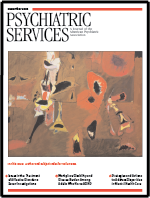To the Editor: The demand for psychiatric services is not random and may fluctuate with climatic variables (
1). Seasonal variability and weather have been shown to predict hospital admissions among patients with major psychiatric disorders (
2). Secondary gain in obtaining shelter from the elements may account for some of these findings.
To address this issue, we examined the relationships between weather and the use of emergency psychiatric services, as well as any relationship to subsequent hospitalization or discharge, at a large, urban, military teaching hospital in Southern California, where patients would have little incentive to seek shelter from the weather. Data from 1,909 emergency department psychiatric evaluations over a one-year period (August 1, 2002, to July 31, 2003) were examined. Evaluations were divided into two groups—patients who were admitted to a psychiatric ward after evaluation (N=900) and those who were discharged from the emergency department after evaluation (N=1,009). The weather variables examined were maximum, minimum, and average temperature; precipitation; average and maximum sustained wind speed; wind direction; and sky conditions (clear to cloudy). Weather data were obtained from the Web site of the National Weather Service.
Linear (Pearson's) correlations were examined between the number of evaluations per day and weather factors. A multivariate, stepwise linear regression model was calculated to predict emergency department evaluations from these factors.
The linear analysis showed weak but significant correlations between temperature and rain and the number of psychiatric evaluations in the emergency department. On rainy days, fewer patients presented for emergency evaluations (r=-.134, p<.01). Among patients who were discharged after evaluation, fewer visited the emergency department on rainy days (r=-.165, p<.01) and on cloudy days (r=-.117, p<.05).
Warmer temperature (high, low, and average) was significantly correlated with the number of psychiatric evaluations. Patients who were discharged after evaluation (r=.131, p<.05) rather than those who were hospitalized accounted for the relationship between emergency evaluations and temperature.
No associations were found between wind variables and evaluation and disposition of patients or between any weather variable and hospitalization.
In the stepwise, multivariate model, only rain and average temperature were predictive of emergency department visits. More patients came to the department on warmer days and on days without rain. Rain accounted for 2.2 percent of the total variance (p=.005), and average temperature accounted for 3.5 percent of the total variance (p=.001). When only patients who were seen but not hospitalized were included, analysis of variance indicated that only rain was a predictor of discharge after evaluation (r2=.031, p=.001).
Even though these correlations were found, no causality can be inferred. Because 1,909 emergency department visits were analyzed, the study had more power than was needed to yield a clinically significant result, which meant that even miniscule relationships being statistically significant. However, the amount of variance accounted for (2.2 to 3.5 percent) is more telling; these results might not have practical clinical application with such a small observed effect. Nevertheless, further investigation is warranted in cities with larger variation in weather variables, where greater effects may be seen.

